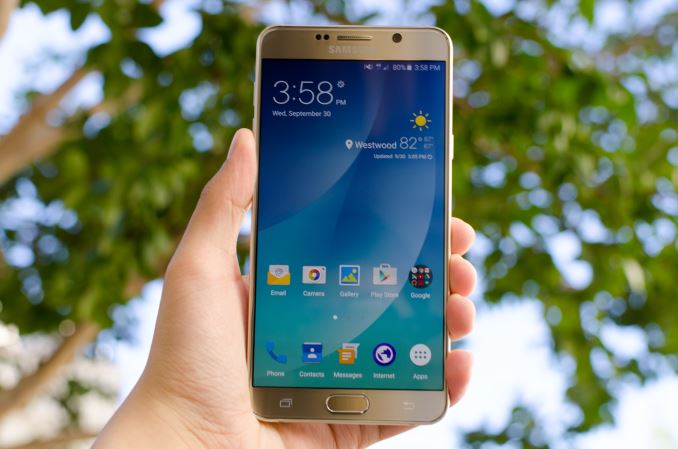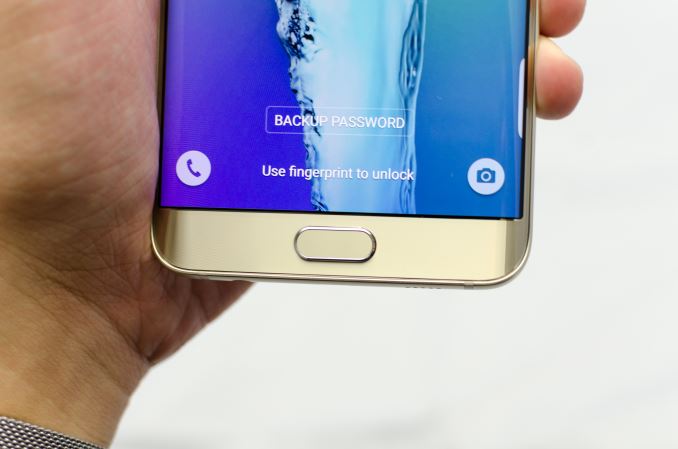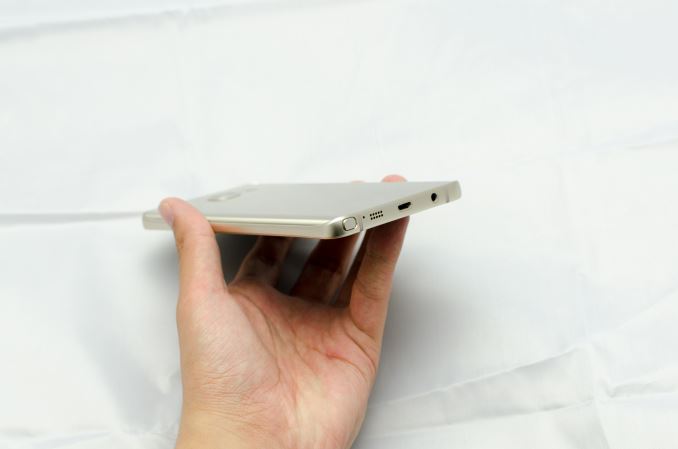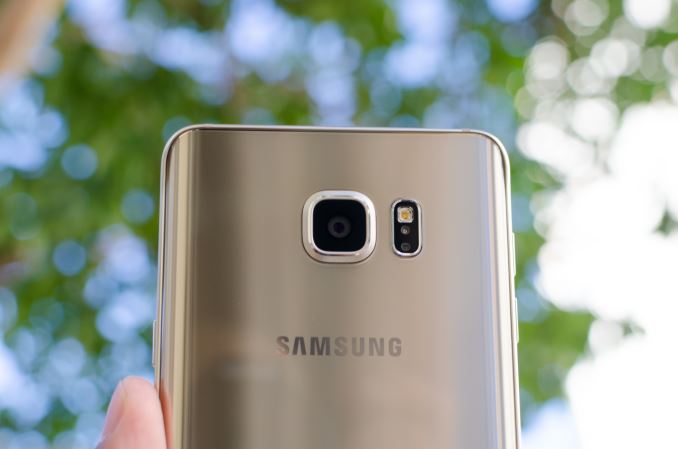The Samsung Galaxy Note5 and Galaxy S6 edge+ Review
by Joshua Ho on October 2, 2015 8:00 AM ESTFinal Words
The Galaxy Note5 is a bit of a break in form for Samsung, but in some ways it represents a return to form. To understand what this means, we can look at the various aspects that make up the Galaxy Note5 in contrast to the Galaxy S6. One of the easier places to start is the design, which shares a great deal in common with the Galaxy S6. We see a similar reflective coating under the glass, a glass back cover, an aluminum midframe, and the usual home button and thin bezels. The fingerprint scanner in the home button works about as well as you would expect and is comparable to the Galaxy S6.
The next aspect of the phone worth looking at is battery life. Here, we see that the Note5 gets a healthy bump in battery life relative to the Galaxy S6. Relative to the Note 4, battery life is basically comparable and not all that different. It seems that Samsung’s theme this year is maintaining battery life by reducing battery size and improving power efficiency. Those looking for a removable battery might be disappointed, but if you never swapped the battery in a phone like the Galaxy Note 4 there’s nothing to really worry about here. Samsung has also retained fast charging capabilities, so it isn’t nearly as important to swap batteries.
The display of the Galaxy Note5 continues to be incredible. Out of all the Android OEMs right now, Samsung is the best at display. I’m still of the opinion that the best LCDs are comparable with Samsung’s latest AMOLED panels, but within the next year or two I’m fairly confident that they won’t have any competition here. However, given the lack of second source suppliers it seems unlikely that OEMs will move en masse to OLED as strongly relying on a single supplier for any critical part of a product could easily be a disastrous mistake. The Galaxy S6 edge+ has a similar level of display quality, but the edges of the display are clearly distorted to the eye due to the subpixel arrangement used.
The SoC used continues to be the best SoC you can get in any mobile device running Android. This is likely to change next year, but given the data it’s incontrovertible that the Exynos 7420 is the fastest and most efficient SoC available in an Android device. These two factors strongly affect user experience in workloads like web browsing, updating and installing apps, and gaming. If you do any of those three things, SoC performance has a strong influence upon overall user experience for you. NAND quality isn’t quite at the same level as the Galaxy S6, but it’s more than sufficient and is unlikely to be a problem for the duration of a two year contract.
Overall, the software experience is actually quite acceptable. TouchWiz has gotten a lot better in the past generation, and any time I pick up a Galaxy S3 or Galaxy S4 I’m immediately reminded of this. However, as mentioned in the Galaxy S6 review I don’t think it’s necessarily perfect. The smoothness of the UI isn’t as amazing as some of the phones I’ve used in the past, and there are sometimes odd choices in application design like icon design. Using a Material Design theme from the theme store goes a long way to dealing with this problem, but that’s no excuse for the default theme. The Note features are useful and the single biggest reason to buy the Galaxy Note5 over another phablet, but the edge features are decidedly impractical and generally not very useful. I still think it's possible to make a better skin than TouchWiz, but I can live with TouchWiz on a primary phone.
In the camera department, on the surface nothing has changed relative to the Galaxy S6. Even if Samsung didn’t do anything for the Galaxy Note5’s camera relative to the Galaxy S6, it would still be one of the best Android cameras you can get today. However, Samsung has included a number of new features like RAW capture and improved manual mode controls. In addition, they’ve dramatically improved low light photo processing to the point that I’m confident in saying that the Galaxy Note5 beats the LG G4 and iPhone 6 Plus, but in video performance the iPhone 6 Plus is still slightly better. The Galaxy Note5 is either as good as or better than the iPhone 6 Plus for overall camera quality depending upon how strongly you want to weight video recording.
Outside of these main areas of focus, overall I like the the Galaxy Note5. In chosing to mimic the Galaxy S6 so closely it's not a bold design for Samsung and you won't find much in the way of new features, but instead what you get is in many ways a big Galaxy S6. Often because of that it's not a perfect phone - Samsung could still afford to work on polish, particularly in regards to issues like inserting the stylus backwards or RAW files that aren’t deleted - however it also does a lot well like the 5.7" SAMOLED display, the camera, and the Exynos 7420 SoC.
If you’re looking for the best Android phablet on the market today the Galaxy Note5 or Galaxy S6 edge+ is likely to be your best bet. They may not be a big jump up from the Galaxy S6, but they're still the best Android phablets you can get today. In that sense, Samsung is departing from the sort of strategy that we saw with the Galaxy Note 3 and 4 in the form of a new SoC and other improvements that came with the Note line, but like the Galaxy Note 1 and 2 these are phablet variants of their Galaxy S cousin.















225 Comments
View All Comments
melgross - Saturday, October 3, 2015 - link
No, not true at all. As far as app sales go, iOS is about twice what Android sales are, in dollars. As far as profits for phone makers go, Apple made 91% of the profits in the cell manufacturing industry, and Samsung made 12%. Everyone else lost money.melgross - Saturday, October 3, 2015 - link
It's pretty well understood that it's meant that flagship phones, and near flagship phones are what are meant.But for cheap smartphones, cheap makers from China and India are crushing Samsung on the low end.
thedons1983 - Sunday, October 18, 2015 - link
When apple actually make a high end phone, then we could answer that, but seeing as everything they manufacture is saddled with their God awful software, we will never know!melgross - Saturday, October 3, 2015 - link
Yeah, when you include $80 smartphones, Samsung does better. But if you consider phones that we would use, Samsung is in trouble. Here, in the states, Apple's sales are 43% and Samsung's are 28%. A similar ratio exists with higher price phones everywhere.In fact, Samsung's sales have been down for at least two years.
thedons1983 - Sunday, October 18, 2015 - link
What a pathetic comment. Everyone in the developed world, knows that the average US consumer is an utter moron. You will buy literally anything, no matter how crap it really is. I guess it's something to do with the woeful education standards in America. Americans = dumb consumers, and we all know it... Well, apart from you, it seems!KoolAidMan1 - Saturday, October 3, 2015 - link
Yes, and most of Samsung's sales are low end devices, not flagships. There is no comparison between iPhone sales and the high end phones from any other OEM.beggerking@yahoo.com - Sunday, October 4, 2015 - link
What you said only applies in the states because American are more naive and uninformed than the rest of the world.For the rest of the world android rule
thedons1983 - Sunday, October 18, 2015 - link
I'm guessing you're not great with numbers then, as higher equals better when it comes to selling. Samsung sells more devices than apple, hence why their sales numbers are higher... Do you see how that works?? Idiot.melgross - Saturday, October 3, 2015 - link
Are you really that paranoid? What is with you guys?tempestglen - Friday, October 2, 2015 - link
I believe the SPEC2006 test on iPhone6S is a big gift for the public.